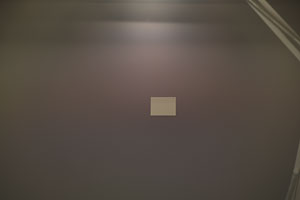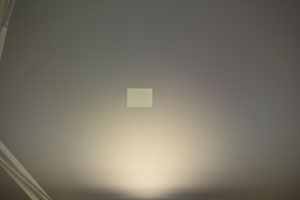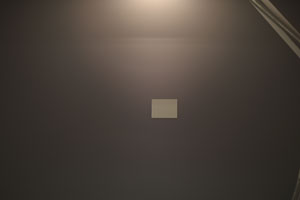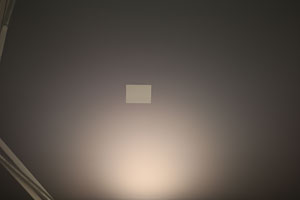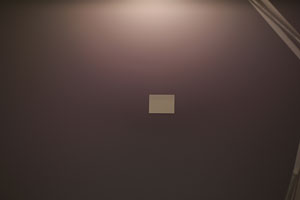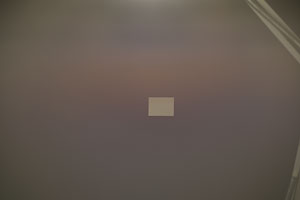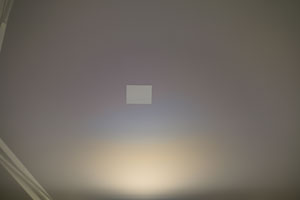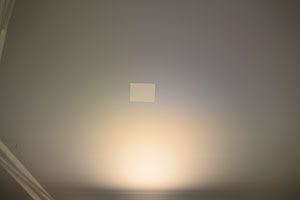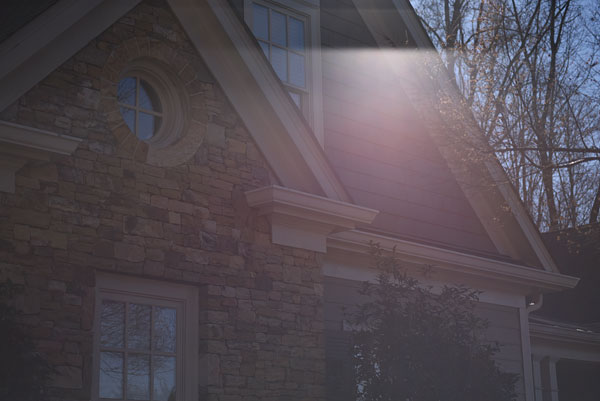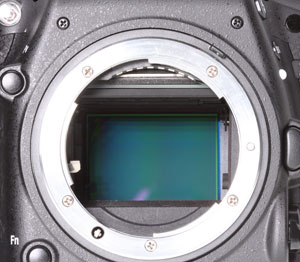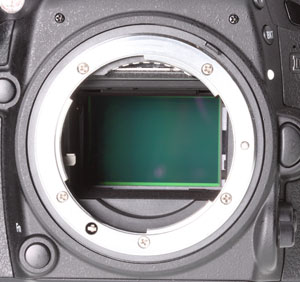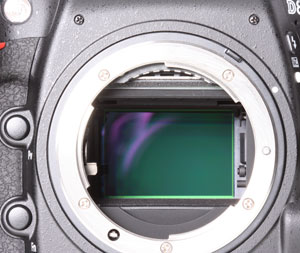Nikon D750 flare problems? Here’s why and what to do about them. (It’s not your lens.)
posted Thursday, December 25, 2014 at 12:33 AM EDT

There have been numerous reports on the web for several weeks now about odd-looking bands or shadows in the flare of backlit photos shot with the Nikon D750. Given the camera's otherwise exceptional capabilities and value, we wanted to investigate the issue in depth, so as to understand both the extent and cause of the problem before reporting on it. We've now completed our testing and analysis, and feel we can definitively answer not only the questions of extent and cause, but also offer an (admittedly pretty awkward) partial workaround to the problem as well.
By way of background, the first examples we saw of the phenomena were in photos taken by wedding photographers aiming for dreamy, flare-filled shots of their brides and grooms. Rather than having a nice smooth gradient of flare running up the frame, these photographers found it interrupted by abrupt, dark bands near the top of the image. They look a lot like shadows caused by something blocking the flare, and as we found, that's exactly what they are.
As typical for IR, we delved into the issue in some depth, and have definitively confirmed both the cause and the extent of the problem, as well as one feasible -- albeit rather awkward -- workaround. Here's what we've learned:
tl;dr: Some number of D750 bodies have a problem with internal reflections -- it's not lens flare -- from the autofocus sensor that lead to strong flare and "shadow bands" appearing in the image. It's not hard to avoid in most circumstances, but in others it's essentially unavoidable. It won't be an issue for some photographers, but will be a big issue for others. (Quick fix: Turn the camera upside down!)
Our test setup
All the problem photos we saw shot by end users had a strong light source -- either the sun or a very bright cloudy sky -- above the frame, so we created a test setup in our lab with a 90-watt floodlamp about four feet in front of the camera, shot against a black background in a darkened room. This gave us a completely reproducible and unvarying lighting setup that we could use to evaluate the impact of different lenses, as well as how other camera bodies responded in the same situation.
We initially shot with one of our lab-standard Sigma 70mm f/2.8 macro lenses, figuring that as an older optic, its coatings might not be up to the level of current technology, and so give us more flare to work with. (Although as noted above, we discovered that the problematic flare doesn't come from the lens, but rather the camera body itself.) We also checked a number of other lenses as well. The problem appeared with all of them, although it seems from other reports on the Internet that the range of light angles that trigger the issue may vary somewhat depending on the focal length. (Most of our own shots were at medium focal lengths.)
We'd also seen some claims that the Canon 6D has a similar problem, but caused by light coming from below the lens, rather than from above. To see to what extent this might be true of the 6D, D750, and other camera bodies, we shot all our lab tests with the floodlamp positioned both above and below the lens. Here's an example of the type of images we found:
How common is this, and do other cameras do it too?
Having heard that the Canon 6D showed a flare pattern for light sources located below the camera, we naturally wanted to explore just how broadly these kind of issues might occur. We certainly couldn't test every camera out there, but did check a number of full-frame models from both Nikon and Canon. Besides the D750, we shot the lighting and background setup described above with the Canon 6D, 5D Mark III, and 1D X, as well as the Nikon D810, D800E, and D610. To be able to assess relative magnitudes of the issue between cameras, we shot with the same lens (the aforementioned Sigma 70/2.8, which we have in both Nikon and Canon mounts), using the same shutter speed, aperture, and ISO settings for all cameras. (Exposure variables were fixed to 1/20 sec. at f/2.8 and ISO 100)
The results were, if you'll pardon the pun, illuminating... ;-)
The table of images below shows the results we obtained with each of the cameras listed. Note that the lighting, camera location, and exposure parameters were identical across all the examples shown, so they should give a good indication of how much or how little each platform suffers from this problem for light coming from both above and below the frame. (One minor exception; we somehow managed to shoot the D810 a third of a stop darker than the others, at 1/25 second shutter time.) Besides the presence or absence of flare anomalies, it's interesting to note just how much difference there is in the overall amount of flare, and differences between having the light source above or below the camera.
|
Nikon D750
|
|
|
With the light coming from above the frame (left), the effect in the D750 is pretty dramatic. Very strong bands of shadow; in this case there's actually three distinct bands visible. With the camera inverted and light coming from just below the lens (right), overall flare is greater, but the banding is greatly diminished.
|
|
|
Canon EOS 6D
|
|
|
There's relatively little banding to be seen here, although there's a faint one perhaps 2/3 of the way up the frame, in the case of light coming from below the lens. It's possible that this would be more evident if it were the sun in that position, rather than a floodlight, but it's really pretty minor, compared to what we saw from other cameras. The overall amount of flare from the top and from the bottom is also much closer to the same.
|
|
|
Canon EOS-1D X
|
|
|
While not as obvious as that of the D750, there's a pretty clear band (with a kind of an "echo" right below it) in the flare coming from the top of the frame. Flare from the bottom of the frame is also significantly worse in the EOS 1D X, but with no sign of banding at all.
|
|
|
Canon EOS 5D Mark III
|
|
|
A bit of odd shadowing at the top, but only a hint of a straight line. A bit more flare from the bottom, and a clear band, near the very bottom of the frame.
|
|
|
Nikon D810
|
|
|
(Accidentally underexposed by 1/3 stop relative to the others.) Even allowing for the slight underexposure, surprisingly little flare of any sort for light coming from the top of the frame, but quite a bit of flare from the bottom. Slight banding on the bottom, very close to the edge of the frame.
|
|
|
Nikon D800E
|
|
|
Very little flare coming from light at the top of the frame, quite a bit coming from the bottom, with some slight banding at the bottom edge of the frame.
|
|
|
Nikon D610
|
|
|
Relatively little flare from the top of the frame, with a faint band. Lots of flare from the bottom, with strong bands, but quite close to the bottom of the frame.
|
|
As you can see, while we saw at least some level of similar issues in other models, the D750 exhibits it quite a bit more than other cameras we tested. We found it interesting that while light coming from below the lens produced much more flare overall, the banding in that situation was greatly reduced
Tests with natural sunlight
Always wanting to tie our lab tests back to the real world, we realized that the floodlight in the lab didn't resemble the sun very much; the sun is much brighter relative to the rest of the scene, and it also covers a much smaller angular area. So we took the D750 outside on a rare sunny day and shot the front of my house in shadow, strongly backlit by the sun just peeking over the edge of the roof, using the same trusty Sigma 70/2.8 as before for the sake of consistency.
Much to my surprise, I found it much more difficult to produce the banded flare with this much brighter, but more concentrated light source than with the more diffuse floodlight in the lab. It turns out that the flare bands only occur over a very narrow range of incident light angles. The sequence above shows the range of effect, as I tilted the camera progressively downwards. In the first shot, the banding pattern is just starting to become visible, in the middle it's about at its peak, and in the bottom shot, it has almost entirely faded out.
The amazing thing (to me, at least) is that the change in camera angle from the first shot above to the final one was just 2.5 degrees. That and the difficulty I initially had in finding the flare with the sun as the light source says to me that it would be pretty easy to avoid in most practical shooting situations when the sun is the cause of the flare. It wouldn't be much of an adjustment to raise or lower the camera just slightly and reframe to change the incident light angle, avoiding the problem entirely.
That said, it's only that easy to get rid of the banding if there's a single, small, bright light source. On the other hand, if you're shooting a large, dark object against a very bright, overcast sky, the banding will occur over a much wider range of angles (since the light source is occupying a much greater vertical angular span). Some internet reports suggest that the range of angles that will produce the banded flare pattern is also a function of the focal length of the lens. This makes sense to us, but we haven't explored that aspect in any organized fashion.
What causes this, and how do we know that it's actually responsible?
A little playing around with a laser pointer made it pretty clear that the stray light that caused the flare was caused by light getting into the AF optics/sensor system, located in a recess in the floor of the mirror box.
As part of confirming this, we very gingerly poked around with a dental pick to gently tug forward the little light baffle that sits behind the AF sensor well when the mirror is up. (Don't try this at home; we were fully prepared to pay for an out-of-warranty D750 repair if we messed up.) The little flap is spring-loaded, so it wasn't too hard to hook it and move it forward and back, with the lens off and the camera in Live View mode. We could reproduce the same sort of shadows we saw with the lens on, by holding a bright flashlight at the right angle above the lens flange. This let us see how various things might affect them.
When we moved the little light baffle flap forward, the main shadow being cast on the sensor and visible in the Live View display very clearly moved in lockstep. The horizontal band of darker area at the top of the frame is just the shadow of the movable light baffle. A little playing with a laser pointer confirmed that the light being shaded was indeed coming from the AF assembly. (Interestingly, it wasn't a "glint" off the top surfaces of the AF optics, as we had expected, but instead a matter of light bouncing around inside the AF optical system, once it initially made its way there.)

That the AF optics are the culprit is also confirmed by the video above, made by Tomasz Piotrowski, who took the very direct step of using a piece of Cinefoil or similar black object to cover the AF recess entirely, and then reattaching the lens and showing the camera's Live View display on its LCD before and after. Along with our own internal tests, this pretty conclusively shows that the AF system is the culprit.
Does this have anything to do with the image sensor?
No, other than that the image sensor is faithfully depicting the light shining on it.
Why don't I see this when I look through the viewfinder?
When you're looking through the viewfinder, you're seeing light reflected by the mirror, with the mirror in its "down" position. The effect we're describing here happens only when the mirror is up, and the autofocus elements and image sensor are exposed to stray light. Switch to Live View mode to see it.
Why do some cameras show this and not others?
As part of our testing, we looked at the mirror-box configuration of all the cameras involved, and were somewhat surprised at the range of variation, showing rather different approaches by which camera designers deal with the problem of internal reflections from the AF system. Cameras with AF sensor arrays more deeply recessed into the bottom of the mirror box are much less prone to this kind of flare problem.
So why would Nikon put the AF elements in such a shallow recess? It's pure speculation on our part, but we'd bet good money that it had a lot to do with trying to cram all that full-frame camera goodness into such a small body. In a full-frame camera, the bottom of the mirror box is always going to be closer to the bottom of the camera itself than in a sub-frame design. When you try to make a full-frame model more compact (or at least shorter), you quickly run out of room between the floor of the mirror box and the bottom of the camera itself. It seems likely that Nikon just walked a bit too close to the edge, when trying to compress the D750 into a shorter package. They obviously were concerned about issues of this sort, hence the little light baffle that flips behind the AF assembly when the mirror is up, but the light baffle proved to not be enough.
But wait a minute: The D610 is also very compact full-frame design, and it shows the problem hardly at all. What's up with that? How is the D750 different from the D610, and and why couldn't the engineers use the same tricks as they employed in the D610?
Again, this is pure speculation, but we strongly suspect the reason comes down to a question of speed. While it's not a huge difference, the D610 tops out at 5.9 frames/second, while the D750 makes it to 6.5. When we looked inside the D610 mirror box, we saw that the AF elements are completely covered by a sliding metal plate when the mirror is up, vs the much smaller baffle on the D750. We're just guessing, but suspect that the D610's sliding plate system takes just enough longer to slide into place and back out of the way again that it would be too slow for the D750.
Of course, there could be any number of other reasons for not using the D610's AF-baffle design, completely apart from speed. It could have proven less reliable, more prone to shedding particles, the actuating mechanism for it could have taken too much space, etc, etc. Whatever the case, we assume there were good and sufficient reasons for ditching it in favor of the flip-back baffle of the D750.
When it comes to other cameras, it generally seemed the case that the deeper the AF system was recessed into the floor of the mirror box, the less likely we were to see banding in the flare patterns. Take a look at the images below, showing the lens mounts and mirror boxes of some of the cameras we tested. For each camera, we show a shot from above, that gives you a glimpse of the AF elements, or at least the recess they're mounted in, as well as a straight-on front shot that shows the size and position of the mirror box, relative to the lens flange.
|
Nikon D750
|
|
|
In the view from above, you can see the recess and a bit of the AF optics within it at the back of the mirror box. The moving flap mentioned earlier is the object running across the back with the horizontal lines on it. (We think that ribbing is probably another measure to reduce reflections.) What you're seeing is actually the edge of a flap that can pivot forward when the mirror is down to let light from the secondary mirror reach the AF assembly. In the front-on shot, you can see that there's not a lot of space between the bottom of the mirror box and the bottom of the lens flange. Not visible here is the distance to the bottom of the camera itself, which isn't a lot.
|
|
|
Canon EOS 6D
|
|
|
In the shot from above, you can see the opening to the AF-system recess, but really not much of the AF optics themselves, as they're buried a bit further below the floor of the mirror box. What we found particularly interesting was the front view, which illustrates one significant difference between Canon and Nikon cameras: Note how much more space there is between the floor of the mirror box and the edge of the lens flange. This is in large part because the Canon flange is so much larger in diameter than Nikon's F-mount. This means that no matter what, Canon is always going to have a certain amount of space below the mirror box floor to play with, unless they hang the rim of the lens flange below the bottom of the camera body.
|
|
|
Nikon D610
|
|
|
We found this one especially interesting: You look into the mirror box and see ... no AF elements! There's a metal plate laid over the top of them, completely hiding them from any stray light! We're not sure why Nikon wasn't able to use this structure in the D750; we speculated it might have to do with speed and frame rate, but that's frankly just guesswork.
|
|
|
Nikon D810
|
|
|
In the D810, there's again a little light baffle that probably pivots up when the mirror's down (we didn't fiddle with it, so aren't sure), but the AF elements clearly seem to be more deeply recessed than in the D750. It's our guess that the deeper recess is the main reason the D810 is so much less susceptible to flare banding.
|
|
Does this happen with all D750s?
We initially thought this was a universal problem with the Nikon D750, at least based on the two samples we've had in our lab, but at least one video on the Internet (see below, also by Tomasz Piotrowski) suggests that there's some variation between D750s, in terms of how the AF elements are positioned relative to the rest of the mirror box and sensor. Both of our samples (serial numbers 3002596 and 3019738) seem to show pretty much the same behavior, and we weren't able to observe any significant difference in the positioning of the AF sensors within their mirror boxes.

Given the video above, it does seem that there could be variations in this area among units out in the field, although how many or when the change was implemented is an open question. As noted, our units had serial numbers 3002596 and 3019738, and both showed the behavior we're talking about; we haven't personally witnessed any samples that didn't show the problem. We'd be very interested in learning whether any of our readers have D750s that don't show the issue, and what their serial numbers are; perhaps we can establish a serial number range where the change occurred.
Here's what we'd like you to do: We're looking for the highest serial number that does show the banded flare, and the lowest number that doesn't show the flare artifact. Currently, the highest number that we know shows it is our own s/n 3019738. We'll pin a post at the top of the comments thread below, showing the current highest/lowest serial numbers, so readers can chime if they're able to extend the known ranges at either end.
Can this be fixed?
The next question of course, is whether or not current D750s that show this behavior can be modified to not do so. Initially, we didn't think so, but the apparent existence of some units with the AF optics recessed more deeply suggests that a fix for the issue may have been developed.
It's hard to imagine this is simply a matter of just a production-line variance and minor change of adjustment, though. To the best of our understanding, any significant change in the position of the AF elements would also require a change in the AF optics, not to mention the underlying structures that the AF system mounts to. I don't know enough about the intimate details of phase detection AF systems, but it seems unlikely that you could accommodate a shift of a millimeter or so in the overall flange-sensor distance electronically. It's conceivable, of course, that this is just a matter of a service-center adjustment, but based on my understanding of the systems involved, that seems unlikely. Again, my understanding here is limited, but it seems like any fix would involve replacing the whole AF sensor/optics array. That sounds like a non-trivial task, if it can be done post-production at all.
Is this just an issue for full-frame cameras, or could it happen with subframe ones as well?
We'd never say never, but this sort of issue is much less likely to occur with sub-frame cameras. Since most sub-frame SLRs have lens flanges sized to be compatible with full-frame models as well, there's generally a lot more space available beneath the floor of the mirror box, so it's easier for the designers to recess the AF elements and keep them out of the way of stray light beams.
A couple of things that surprised us
A couple of things really struck us about this test.
Duh! It's often the camera body, not the lens! First and foremost, we -- like other photographers -- are accustomed to blaming flare on our lenses. It turns out that in many cases, our camera bodies are contributing more to flare than our lenses are. The examples shown above were all shot with the Sigma 70mm, but tests on the D750 with a variety of other lenses produced very similar results. Given how much difference there was between cameras, and how little flare we saw for light coming from above the lens in some of them, it seems clear that the bulk of the flare we see in the shots above came from the cameras themselves. While most cameras didn't produce as much banding as we saw with the D750, it's clear that pretty much all of the bodies were responsible for significant amounts of the flare we observed. It's certainly (and obviously) true in many cases that the lenses produce flare in many situations, but this test was a real eye-opener for us in terms of how much flare the camera bodies themselves produce.
Flare is often a lot different from the top than from the bottom. I guess it makes sense that camera makers would optimize their mirror box designs to minimize flare from light sources coming from above the frame, but we were really surprised to see just how much more flare was present in a lot of cases when the light source was below the lens/camera. (Given that the sun is usually overhead, it makes sense to do whatever possible to reduce the internal reflections coming from that direction.) We found this particularly surprising, though, given that the top of the mirror box was usually pretty plain, with no obvious sources of reflection. What's up there is the backsides of the primary and secondary mirrors, and they're both pretty well black-matte coated. But that coating generally seems much less effective than what's on the bottoms of the mirror boxes. Is the coating actually different, and there's some reason they can't use the same coating on the rapidly-moving, high-shock surfaces of the mirrors, or is it just that the openings in the mirror box floor for the AF sensors can actually help with internal reflections, more than reflections from the AF optics hurt? We're not certain.
How can I avoid banded flare patterns?
First and foremost, note that this only happens when the sun or flare source is just outside the frame. As noted above, you'll only see banded flare like this if you're shooting with the sun or other strong light source just outside the frame; as far as we've been able to tell, it doesn't happen if the sun is actually within the field of view. This one fact should quell the concerns of most users. While a lot of people shoot backlit subjects, the chances are good that they'll either have the sun or light source itself appearing in the frame, or at a high enough angle above the camera that it won't trigger the phenomenon. So 99% of the time, you can just relax and forget that the issue exists.
It's always best practice to shoot with a hood, to avoid just this sort of problem. In this case, though the light source needs to be at such a shallow angle relative to the axis of the lens to trigger the effect that a hood may not help. Especially in the case of zoom lenses used at their tele ends, the hood probably won't help much since it has to be designed to not obstruct the view at the lenses' wide angle ends.
It's a bit of a pain, and wouldn't work for action shooting, but the guaranteed-effective solution is to shade the front of the lens with your left hand. This worked fine for the mostly-smaller lenses we tested with the D750, but would obviously be a non-starter with a 70-200mm f/2.8.
Finally, while it would be awkward in practice, if you don't need to take a lot of shots with the sun just outside the frame, a pretty straightforward solution is to simply hold the camera upside-down. If you're looking for an artistic flare effect, you'll get more of it in this position anyway, and there's a good chance that the amount of banding with the light coming from "beneath" the lens wouldn't be noticeable. This is a pretty awkward shooting position, but then how often do you need to put the sun just outside the frame, vs either in the frame or a lot outside of it?
It bears repeating: This banded-flare problem only occurs for a very small range of angles, and as far as we can tell, not at all when the flare source is included in the frame with the subject. There's still the potential situation where a broad swathe of bright sky triggers the effect, but again, including the flare source within the frame will most likely avoid the problem entirely.
Is the Nikon D750 still a good camera? Should I buy one?
This is obviously a personal question; you'll have to ask yourself how often you'll be shooting under conditions that are likely to trigger it. It will be a show-stopper for some, but speaking purely for myself, I wouldn't hesitate to buy a D750 if I were in the market for a full-frame DSLR. It's a joy to hold and to shoot with, and its image quality apart from the flare issue is absolutely superb. Personally, it's very, very seldom that I'd shoot backlit scene of the sort that shows the problem.
That's just me; I'd buy a D750 in a heartbeat if I was in the market for a full-frame SLR, even with the current flare issue present. I do realize, though, that some photographers may often shoot under conditions that would produce banded flare like we've seen above. It's clearly something that the camera would be better of not exhibiting.
Summary
So that's where we are at the moment. At least some D750s will produce banding in their flare patterns across a fairly narrow range of light angles if the light source is just outside the frame, above the lens. If the light source is broader and more diffuse, the banding will also be broader and harder to avoid, but from what we've seen, it becomes a non-issue if the flare source is within the frame rather than outside it, or if it's at a higher angle. There's at least some evidence to suggest that not all D750s show this issue, but we don't know how many of these there are, at what point in the production run any related change was made, or just how free of the issue they may be.
While we don't think it's as big an issue as it's been made out to be, it does happen with some samples, and it would probably be useful to identify the range of serial numbers that are affected, for the sake of prospective owners who commonly take the kinds of shots that would trigger the behavior.
Here's what we'll do: We've pinned a post to the top of the comments thread below, showing the current highest serial number we're aware of that *does* show the issue, and the lowest serial number we're aware of that doesn't. (We're assuming that if any models don't display the behavior, they'd be more recently produced ones, with higher serial numbers.)
See the example images above from our tests in sunlight, to see what to look for; if the worst-case you can produce with your D750 is significantly less than the worst shown above, please post a sample image and the serial number of your camera in the comments below. On the other hand, if your camera does show the problem, and you have a serial number higher than the lowest one shown in the pinned post below, please let us know what your serial number is. (If your serial number is below the lowest or above the highest one shown in the post, please don't bother posting an image or your serial number; it won't expand the known ranges any.)
We'll also reach out to Nikon, to see what their comment on this might be, but this story is going up right as the Christmas holiday arrives here in the US, so it could be a while before we receive a reply.
Please let us know your thoughts and (especially) your experiences below!
UPDATE: Nikon has released an official statement regarding the issue
